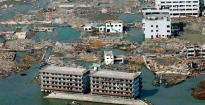Will Crisis Jump-Start Japan?
 Marcus Noland writes in the Washington Post:
Marcus Noland writes in the Washington Post:
On Sept. 1, 1923, a 7.9-magnitude temblor struck Tokyo. More than 100,000 people lost their lives and more than 3 million were left homeless in the Great Kanto Earthquake. Fueled by rumors that ethnic Koreans were poisoning water wells, mobs killed thousands of Koreans in the days that followed. The Japanese government declared martial law, but the civilian authorities’ inability to deal with the disaster contributed to an eventual military takeover.
Seventy-one years later, on Jan. 17, 1995, Kobe was hit by a 6.9-magnitude quake. The Great Hanshin Earthquake killed 6,400 people. Damage was estimated at more than $100 billion, or 2.5 percent of Japanese national income — similar to current estimates of the toll of last week’s 9.0-magnitude temblor in the Tohoku region of northern Japan. Yet, within 18 months, economic activity in Kobe had reached 98 percent of its pre-quake level. A state-of-the-art offshore port facility was built, housing was modernized — and a scruffy port city became an international showpiece.
It is tempting to regard the different responses to these tragedies as proof that a more advanced society will respond more constructively to adversity. The simpler truth is that disasters can quickly transform a nation — for better, or for worse.
Which way will Japan go?
The March 11 earthquake and tsunami devastated a society that, for all its wealth, was stuck in a rut. Over the past two decades, Japan’s economic growth averaged an anemic 1 percent a year. Politically, the country was rudderless. The Liberal Democratic Party, which had governed almost continuously since the end of the U.S. military occupation following World War II, had finally worn out its welcome. And the novice Democratic Party of Japan, which had assumed power in 2009, was flailing.
For four decades after the war, Japan experienced cozy politics backed by a robust economy. Lightly populated rural districts had a disproportionate effect on national politics. The government financed multibillion-dollar bridges to nowhere, expensive port facilities for small fishing villages and bullet trains to traverse bucolic rural areas — and seemingly lined every riverbed in Japan in concrete.
But in 1990, the bubble burst. The working-age share of the population began to fall. In 1998, the labor force started to shrink, and a decade later, the country’s population began to decline. Eventually, voters concerned about the mounting costs of wasteful projects tossed out the LDP.
Before the earthquake and tsunami devastated the Tohoku region on March 11, the country was already facing a slowing economy, fiscal strain and deflation, and decades of wasteful spending had saddled the country with a debt more than twice the size of the economy. Now, beyond the tragedy’s human toll, the economic costs are still being counted — and could be vastly expanded if the nuclear reactor damage is closer to that of Chernobyl than to Three Mile Island. But if rebuilding is handled skillfully, there is hope that a different kind of Japan will emerge.
Despite its weak starting point, the government holds a few cards. Ninety-five percent of Japan’s debt is owned by its citizens, not foreign hedge funds; it’s unlikely that those citizens would dump their bond holdings if the government takes on more debt to rebuild the city of Sendai, for example. Financially, the government has more maneuvering room than might seem apparent.
Some rebuilding can be financed by redirecting spending from useless white-elephant projects to the higher priority of remaking Tohoku. The quality of public investment in the nation could improve, perhaps permanently, as a result of this crisis.
Japan’s shrinking labor force could constrain the country’s ability to rebuild — thus forcing politicians and the public to confront its misgivings about immigration. Japan has long exerted tight control of its borders and makes it difficult for foreigners to live and work in the country. Among leading industrial nations, only South Korea has a lower share of foreigners in its workplaces. The foreigners now in Japan fall into various niches: highly skilled white-collar expatriates; low-skilled, often illegal, laborers; imported rural brides. Economists have long argued that Japan needs to welcome more workers to remain economically competitive. The imperative to rebuild housing and infrastructure on a massive scale could force this immigration challenge into the open. ...
Click here to read more.

